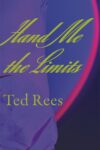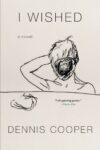 The prolific poet, novelist, performance artist and essayist Dennis Cooper has said that the idea for his new film project, a collaboration with the French-American artist Zac Farley (no relation), began years ago as an idea for a new kind of porn movie. The final product could conceivably be called this. Cooper has also said that writing Like Cattle Towards Glow’s script was truly a team effort with Farley, though the film deals with the older writer’s primary artistic concern: representing the shapes of power that come into play at the precipice between sex and death, which in the film’s world is a void both deep and thin.
The prolific poet, novelist, performance artist and essayist Dennis Cooper has said that the idea for his new film project, a collaboration with the French-American artist Zac Farley (no relation), began years ago as an idea for a new kind of porn movie. The final product could conceivably be called this. Cooper has also said that writing Like Cattle Towards Glow’s script was truly a team effort with Farley, though the film deals with the older writer’s primary artistic concern: representing the shapes of power that come into play at the precipice between sex and death, which in the film’s world is a void both deep and thin.
Structurally porn-like, LCTG is composed of five decontextualized scenes in which the viewer is confronted with the un-porn-like question of whether anything ever really changes. That said, I don’t think it will really change anything to tell you what the scenes are.
- A young man hires a male prostitute who can dramatically slow his metabolism. The john is trying to process the suicide of a friend that occurred after the john rejected him as a lover.
- A young male in a dark punk club screams into a microphone all of the violent traumas he or people close to him have suffered. Two male audience members who seem like they’re part of the show hold the performer down, finger his asshole and force their penises into his mouth while the performer goes on with his confession.
- A young man asks another young man if he has any heroin, and says that he’ll fuck in exchange for some, then mentions offhandedly that he’ll be dead in two days anyhow. They walk through a field in the Paris suburbs and the one with the heroin says it’s his uncle, well not really his uncle, that really wants to fuck the boy who wants the heroin. Then they’re on the ground and the one with the heroin is rimming the other one. Sounding totally resigned to everything, the receiver says he’s going to freak if guys keep doing this to him. He’ll be dead in two days anyway. The one with the heroin is fisting the kid and says he loves him and wants to protect him.
- A young man and woman are in a tent in the snow and dressed in Krampus costumes. They chase and pin down a young male passerby and debate whether it would be a violation of their newfound principles to rape the guy. On the one hand, they’d have to return to their human forms because the costumes don’t have zippers. But then again, “the point is to change assumptions about yourself” so they do it, but then they just kill the guy instead. Then a group of creepy middle aged people stumble upon them – “It’s those anarchist weirdos, Antoine and Marcel!” They beat Antoine and Marcel and maybe they rape them, it’s hard to tell. “Fascists,” mutters and bloody and unmasked Antoine.
- A drone helicopter follows a young man into a cave on a beach and there are cameras inside the cave. The man lies down in a sleeping bag in the cave and a woman controlling the drone and cameras starts talking to him over a pretty Bond-like audio setup. It’s obvious they’ve been doing stuff like this for a while. The man says he’s worthless, broken. The woman says how turned on she is by the guy’s damage. Both she and he, like all of the characters, are apparently played by French non-actors speaking in English, but besides the accents it doesn’t show.
Watching the film is akin to experiencing the surreal as it exists in real life, like a hollowed out version of real life. The images, courtesy of cinematographer Michael Salerno, are both digitally stark and cheap but emotive, sometimes beautiful. The use of Sandy hook shooter Adam Lanza’s portrait above the death-fetish bed in the first scene is perhaps a bit much, though according to Cooper at the film’s Montreal premier, the photograph was a gift from John Waters. Music serves LCTG, as in the nightclub scene where the traumatized performance artist is shouting against this kind of dance-able noise music this guy with a laptop is making, though the silences are most interesting, often awkward and always infused by specific pain.
Male or female is beside the point. As in most of Cooper’s fiction and poetry, character and plot are beside the point. It’s bodies that are used to complicated effect. Subtle movements reveal wide power plays. This is what the movie is arguably best at. In the first scene, when the prostitute, slouching toward the fetal position and tearing up, mumbles that he needs the money when asked why he is faking being dead. Later, the john, splayed godlike and pantless above the camera, tells the prostitute, “Even if you only did it for the money, thank you.”
These are bodies at the moment of encounter with crisis, and there is a kind of saintliness to their response. Even to death and in their assholes. That this humanistic tension is so palpable owes to the strong structural constraints placed upon the bodies, despite, and in interesting contradiction with, the film’s apparent resistance to linearity. It lends to these vignettes an impression that the confusion of these bodies is our own. When the junkie kid fists the kid who says he’s going to die anyway, the viewer gets the impression that both are submitting to some other fist that’s huge and abstract.
To the extent that there are protagonists contained in these bodies, they are wounded by objectification. They’re bored by it, they’re sick of it, of even their own desire. With living. And yet, by some mystery called glow, they’re drawn to it for reasons that no one in the world seems clinically qualified to articulate.
The film’s violence is the genuinely spiritual kind. A loud expression of the alienation that hums constantly in the elevator music to modern life.
This post may contain affiliate links.







